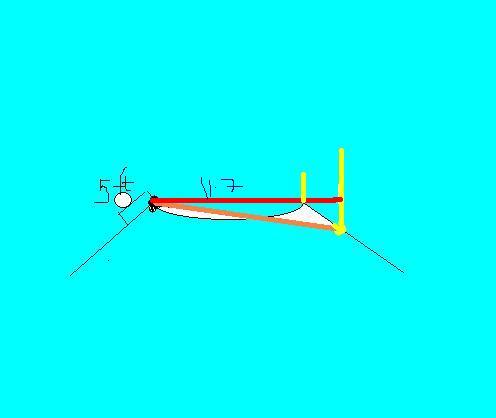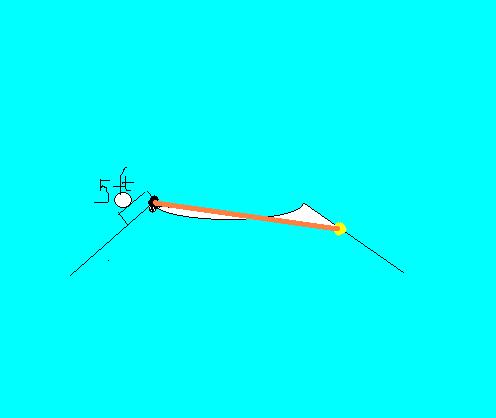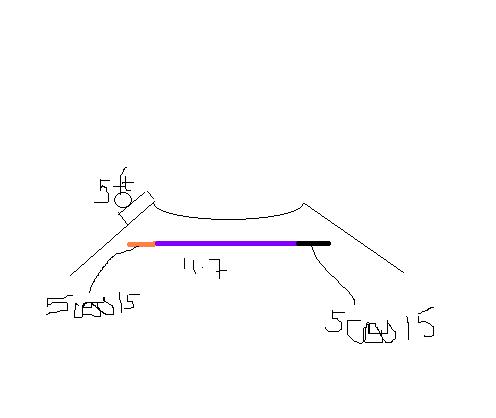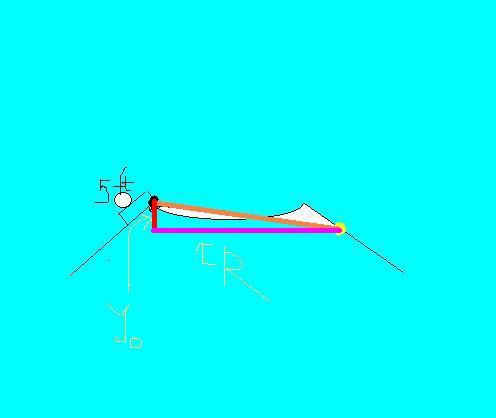Understood rite john?
with wat minimum speed shud a motorbike be moving on the road to safely cross a 11.7ft wide ditch with approach roads at an angle of 15 degree with the horizontal.assume length of bike is 5 ft and it leaves the road as soon as front part runs out of approach of road.
-
UP 0 DOWN 0 0 30

30 Answers
Yes.... range is horizontal distance n here no slanting line......
Virang ur approach is correct ,but why 5 * cos 15 ... why not 2.5 *cos 15?? coz once if the COM of bike crossesthe mark den the bike can b safe....
john here you have to find y when x= the highest point on the curve.. the one with the smaller yellow marker on the ground..
If it is -ve then it will fall before it
else it will go beyond the cliff to the second yellow marker in virang's post. :)

The extra red part is 5cos15
Consider the front tyre to be air and rear tyre touchs the slope and then the front tyre comes down
Ok john for you i will give a very easy approach i just thought of posting in my next post
haha...Virang is getting the same ans as mine:)
But Anand...u hav 2 use some approximations for solving such problems...
there wasnt huge error in wat i did...
it leaves the road as soon as front part runs out of approach of road.
this is from the q .
Since it can be assumed that the bike leaves when the front part leaves, It can also be asumed that it reaches when the front part reaches
so only 5cos15+11.7
john if you are not satisfied
try to solve this
y=xtanθ-gx2sec2θ/2u2
where θ=15°, x=11.7+5cos15, y=-5sin15
try to find answer from this
See my view is that the bike mass is not uniformly distributed and therefore COM cannot be efficiently and accurately be calculated from the given data.
This is my view
@sriraghav and virang
BTW sriraghav no need of COM read ques again
damn sure explanation u r giving is wrong.
remember drivation of range formula is done itself by taking
y=0 which gives time of flight.thru which we get formula for range
.but here y= -ve.got it???????????
i don think this is correct.
remember there we used equations of motion not the formula.
[3]
do you remember problems where the ball is hit by a batsmen from a few metre from the ground and you have to find the range do you remember and therefore we took y0 = The ball faced level(few metre)
But range has nothing to do with the y0 and therefore the range is 16.5
hmmm.... nice Q, Can use centre of mass concept here...(just an idea), ie the centre of mass of the bike

oh dude in this pic. the line represents range.
clearly starting and ending points don lie on same line.
then how can u use formula which is applicable for projectile starting and ending at same line
See Range = 11.7 + 5cos15
And not 2(5cos15) since you have to consider only landing since the question says that the projectile starts as soon as the first tyre leaves the slope.
Therefore Range = 11.7 + 5cos15
Now cos 15 = 0.96
11.7 + 5*0.96
11.7 + 4.8
=16.5
R = u2Sin30/32
16.5*32 = u2*1/2
33*32 = u2
u = 32.1
u ≈ 32ft/sec
Got it understood but since cos 15 = 0.96 ≈1
Therefore i was adding 5 directly
oh dude!!!pink to that solution.
@nishat sir
we can only apply that formula if both starting and ending point lie on same horizontal line

now
from above diagram u can see clearly range shud be 11.7+5cos15+5cos15
then tell me y to take range as 16.7?????????
Arey...see , if v just conssider the movement of d front wheel, it covers 16.7 ft na?
If it wud hav covered 11.7 ft, the bike wud hav fallen in the ditch!
no optimus that does not help!calculating that way we don get correct ans.
